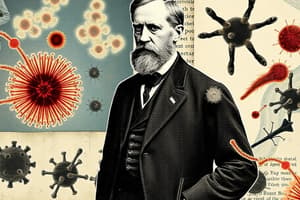Podcast
Questions and Answers
What is the process called when milk is heated to a temperature of 50 or 60 degrees centigrade to make germs harmless?
What is the process called when milk is heated to a temperature of 50 or 60 degrees centigrade to make germs harmless?
Pasteurization
What branch of science did Louis Pasteur found?
What branch of science did Louis Pasteur found?
Bacteriology
What did Louis Pasteur believe was the cause of most infectious diseases?
What did Louis Pasteur believe was the cause of most infectious diseases?
Bacteria
Who had already discovered vaccination for smallpox before Pasteur's time?
Who had already discovered vaccination for smallpox before Pasteur's time?
What did Louis Pasteur spend three years tracking down the cause of, which had ruined the silkworm industry?
What did Louis Pasteur spend three years tracking down the cause of, which had ruined the silkworm industry?
What did Louis Pasteur experiment with in his laboratories to help his fellow human beings?
What did Louis Pasteur experiment with in his laboratories to help his fellow human beings?
What was the purpose of Pasteur's experiment with bottles of soup in different locations?
What was the purpose of Pasteur's experiment with bottles of soup in different locations?
What was the result of the bottles opened in the hotel bedroom in Pasteur's experiment?
What was the result of the bottles opened in the hotel bedroom in Pasteur's experiment?
Why did Pasteur open some bottles of soup on a high mountain in his experiment?
Why did Pasteur open some bottles of soup on a high mountain in his experiment?
What did Pasteur's experiment with the bottles of soup demonstrate about the importance of pure air?
What did Pasteur's experiment with the bottles of soup demonstrate about the importance of pure air?
What term is used to describe the process discovered by Pasteur to prevent wine from souring?
What term is used to describe the process discovered by Pasteur to prevent wine from souring?
How did Pasteur's experiments contribute to the understanding of spontaneous generation?
How did Pasteur's experiments contribute to the understanding of spontaneous generation?
What was one of the main problems Louis Pasteur was trying to answer?
What was one of the main problems Louis Pasteur was trying to answer?
Explain the concept of 'spontaneous generation' and how it related to the belief about germs at that time.
Explain the concept of 'spontaneous generation' and how it related to the belief about germs at that time.
Describe Louis Pasteur's experiment to prove his theory about the origin of germs.
Describe Louis Pasteur's experiment to prove his theory about the origin of germs.
What was the significance of the bend in the bottle neck in Pasteur's experiment?
What was the significance of the bend in the bottle neck in Pasteur's experiment?
How did Pasteur show that germs from the air could contaminate the soup in his experiment?
How did Pasteur show that germs from the air could contaminate the soup in his experiment?
What was the role of dust in Pasteur's experiment and how did it relate to the contamination of the soup?
What was the role of dust in Pasteur's experiment and how did it relate to the contamination of the soup?
Flashcards
Pasteurization
Pasteurization
Heating milk to 50-60°C to kill harmful germs.
Bacteriology
Bacteriology
The branch of science studying bacteria.
Bacteria
Bacteria
Microscopic organisms that cause many infectious illnesses.
Vaccination
Vaccination
Signup and view all the flashcards
Silkworm Disease
Silkworm Disease
Signup and view all the flashcards
Research
Research
Signup and view all the flashcards
Soup Experiment Purpose
Soup Experiment Purpose
Signup and view all the flashcards
Hotel Bedroom Soup Result
Hotel Bedroom Soup Result
Signup and view all the flashcards
Mountain Soup Test
Mountain Soup Test
Signup and view all the flashcards
Pure Air Importance
Pure Air Importance
Signup and view all the flashcards
Pasteurization (Wine)
Pasteurization (Wine)
Signup and view all the flashcards
Disproving Spontaneous Generation
Disproving Spontaneous Generation
Signup and view all the flashcards
Pasteur's Main Question
Pasteur's Main Question
Signup and view all the flashcards
Spontaneous Generation
Spontaneous Generation
Signup and view all the flashcards
Pasteur's Germ Origin Experiment
Pasteur's Germ Origin Experiment
Signup and view all the flashcards
Swan Neck Function
Swan Neck Function
Signup and view all the flashcards
Germ Contamination Demo
Germ Contamination Demo
Signup and view all the flashcards
Dust's Role in Contamination
Dust's Role in Contamination
Signup and view all the flashcards




